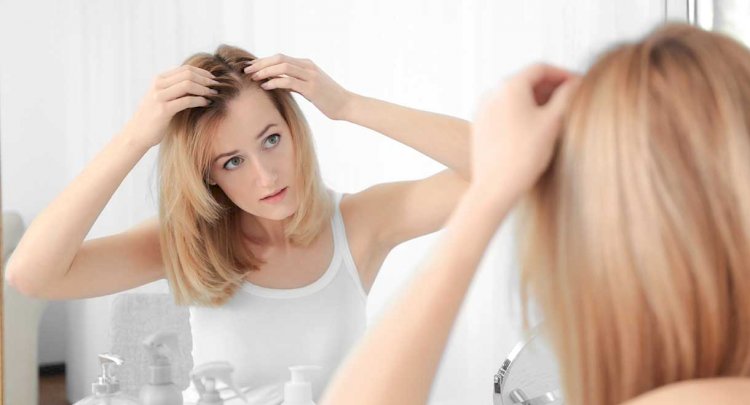Here Are The Right Treatments For Female Hair Loss – Part 1
Now we know why badness occurs in women. What are the causes and remedies? We explain them in detail.

Female Pattern Baldness
For a variety of reasons such as genetics, changing hormone levels as also a part of the natural aging process happens the female hair loss.
Including topical medications such as Rogaine, there are various treatment options for female hair loss. Light therapy, hormone therapy, or in some cases hair transplants are other options.
To help keep hair healthy, you need to eat a nutritious diet and maintain a healthy lifestyle.
1. Minoxidil
Female hair loss is caused by a variety of issues.
To treat hair loss, the Food and Drug Administration approves Minoxidil.
People can purchase topical Minoxidil over-the-counter sold under the name Rogaine, as well as other generic brands. People report a high satisfaction rate after using it as Minoxidil is safe for both males and females.
Increasing their growth cycle, minoxidil stimulates growth in the hairs. Reducing the appearance of patchiness or a widening hair parting, it can cause hairs to thicken.
Available in two concentrations are minoxidil treatments: requiring a twice-daily application for the best results, the 2% solution, and also requiring daily use is the 5% solution or foam.
It is not necessary while the instinct may be to choose the stronger solution whereas it was found that 2% minoxidil was effective for females with androgenetic alopecia, or pattern baldness by studies posted to the International Journal of Women’s Dermatology and the Journal of the American Academy of Dermatology.
They should continue using it indefinitely if a person finds success with minoxidil. The hairs that depended on the drug to grow will likely fall out within 6 months when a person stops using minoxidil.
Uncommon and generally mild are the side effects of minoxidil. To ingredients in the product such as alcohol or propylene glycol, some females may experience irritation or an allergic reaction. It may help alleviate symptoms, by switching formulas or trying different brands.
When using minoxidil, some females may also experience increased hair loss at first. As the hair gets stronger this typically stops after the first few months of treatment.
It may cause hair growth in these areas when misapplying minoxidil or applying it to the forehead or too much of the neck. To avoid these side effects, apply minoxidil to the scalp.
2. Light Therapy
It may act to amplify the effects of other hair loss treatments, such as minoxidil, as low-level light therapy may not be sufficient treatment for hair loss on its own.
It was found that compared to control groups adding low light therapy to regular 5% minoxidil treatment for androgenetic alopecia helped improve the recovery of the hairs with the participant’s overall satisfaction with their treatment as a trial posted to the Indian Journal of Dermatology, Venereology, and Leprology. To help strengthen these results, researchers will need to carry out further research.
3. Ketoconazole
Where inflammation of the hair follicles often contributes to hair loss, the drug, ketoconazole helps treat hair loss in some cases. It was noted that topical ketoconazole might help reduce inflammation improving the strength and look of the hair as one review posted to the International Journal of Women’s Dermatology.
Available as shampoo is ketoconazole with the best brand is the Nizoral available for purchase over the counter and online. Stronger concentrations will require a prescription from a doctor as Nizoral contains a low concentration of ketoconazole.
4. Corticosteroids
In certain cases, some females respond to corticosteroid injections. For conditions such as alopecia areata, doctors use this treatment only when necessary. Here the condition of alopecia areata results in a person’s hair falling out in random patches.
Injecting corticosteroids directly into the hairless patch may encourage new hair growth according to the National Alopecia Areata Foundation. Whereas it is possible that this may not prevent other hair from falling out. It may reduce har loss where topical corticosteroids are available as creams, lotions, and other preparations.
5. Platelet-Rich Plasma
Injections of platelet-rich plasma may also help reduce hair loss as early evidence suggests. The procedure involves a doctor drawing the blood and separating the platelet-rich plasma from the blood thereby injecting it back into the scalp at the affected areas helping speed up tissue repair.
Most studies suggest that this therapy reduces hair loss increasing hair density and increasing the diameter of each hair, as noted in a recent review posted to Aesthetic Plastic Surgery.
The review calls for more research using platelet-rich plasma for androgenic alopecia because most studies up until now have been very small.
6. Hormone Therapy
Doctors may recommend some form of hormone therapy to correct them if hormone imbalances due to menopause for example cause hair loss.
They include birth control pills and hormone replacement therapy for either estrogen or progesterone as some possible treatments.
Antiandrogen medications such as spironolactone are other possibilities. Hormones that can speed up hair loss in some women are androgens that happen to be the cause in those with polycystic ovary syndrome that typically produces more androgens.
Preventing hair loss is antiandrogens stopping the production of androgens. Always talk to the doctor about what to expect and whether antiandrogen is suitable as these medications may cause side effects.
Here We Continue The Discussion
There are more treatments for baldness in women. They are sure-fire treatments that help to reverse the effects of baldness.
What's Your Reaction?





















